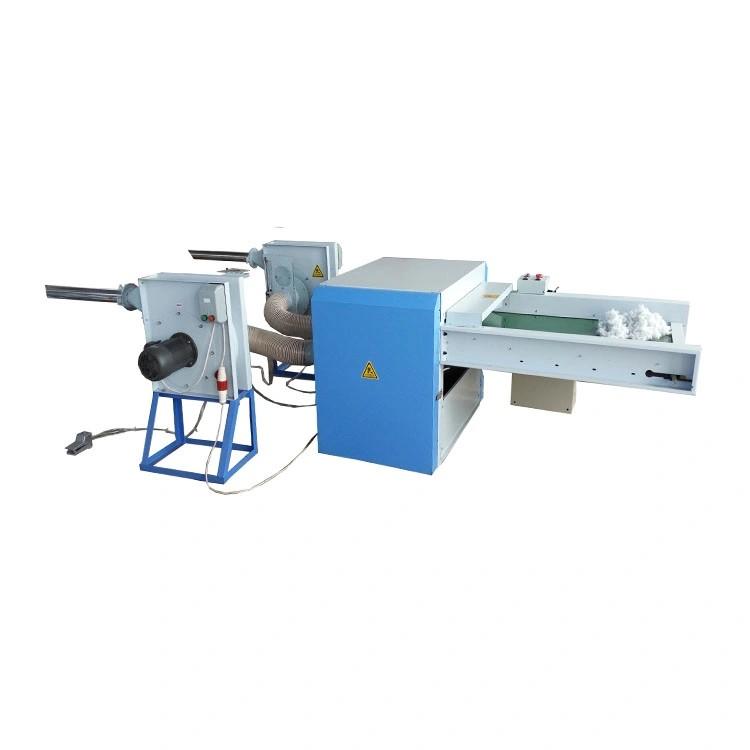Advantage of using fiber opening machine in textile industry

The use of fiber opening machines in the textile industry offers several significant advantages:
1. Increased Efficiency: Fiber opening machines automate the process of separating and loosening fibers, which significantly reduces manual labor requirements and increases production efficiency. This automation allows textile manufacturers to process larger volumes of fibers in less time, thereby improving overall productivity.
2. Improved Fiber Quality: Fiber opening machines are designed to handle various types of fibers, including natural fibers like cotton and wool, as well as synthetic fibers such as polyester and
nylon. By effectively opening and blending fibers, these machines ensure uniformity in fiber distribution and consistency in the final textile products, leading to higher quality end results.
3. Enhanced Versatility: Fiber opening machines are versatile and can be adapted to process different types of fibers, blends, and textures. This versatility allows textile manufacturers to produce a wide range of products, from lightweight fabrics to heavy-duty materials, while maintaining consistent quality and performance.
4. Waste Reduction: By efficiently separating and opening fibers, these fiber opening machines help minimize waste and optimize material usage. This is particularly beneficial in reducing the amount of unusable fiber trimmings or scraps generated during the manufacturing process, leading to cost savings and improved sustainability.
5. Cost Savings: The automation and efficiency provided by fiber opening machines result in cost savings for textile manufacturers. By reducing labor costs, improving production throughput, and minimizing material wastage, these machines contribute to overall operational efficiency and profitability.
6. Customization and Innovation: Advanced fiber opening machines often come equipped with customizable features and settings that allow manufacturers to tailor the processing parameters according to their specific requirements. This flexibility enables innovation in product development and facilitates the creation of unique textile designs and textures.
7. Consistency and Reliability: Fiber opening machines deliver consistent and reliable results, ensuring uniformity in fiber processing and product quality. This consistency is essential for meeting strict quality standards, adhering to customer specifications, and building trust with consumers.
Overall, the adoption of fiber opening machines in the textile industry enables manufacturers to streamline operations, enhance product quality, reduce costs, and stay competitive in a dynamic market environment. These machines play a crucial role in driving efficiency, innovation, and sustainability across the textile supply chain.
Why a Fiber Opening Machine?
Investing in a fiber opening machine offers various compelling reasons for textile manufacturers and producers. Here are some key advantages of using a fiber opening machine:
1. Automated Processing: Fiber opening machines automate the labor-intensive process of separating and blending fibers. This automation reduces manual handling, minimizes human error, and increases overall production efficiency.
2. Increased Production Capacity: By accelerating the fiber opening and blending process, these machines enable manufacturers to handle larger volumes of raw materials, leading to higher production output and scalability.
3. Improved Fiber Quality and Consistency: Fiber opening machines ensure uniform fiber distribution and consistency, resulting in higher-quality end products. This uniformity enhances the aesthetic appeal, performance, and durability of textiles.
4. Waste Reduction: Efficient fiber separation and blending minimize material wastage by utilizing more of the raw fibers and reducing the generation of unusable scraps or trimmings. This waste reduction contributes to cost savings and sustainability efforts.
5. Versatility and Flexibility: Fiber opening machines can process various types of fibers, blends, and textures, offering manufacturers the flexibility to produce a diverse range of textile products to meet market demands.
6. Cost-Efficiency: Over time, the operational efficiencies, reduced labor costs, and minimized material wastage associated with fiber opening machines can lead to significant cost savings for textile producers.
7. Customization and Innovation: Advanced fiber opening machines often come with customizable features and settings, allowing manufacturers to experiment with different fiber blends, densities, and finishes to create innovative and unique textile designs.
8. Consistent Performance: Fiber opening machines deliver consistent and reliable performance, ensuring that the production process meets quality standards and customer expectations consistently.
9. Safety and Ergonomics: By automating the fiber handling process, these machines reduce the risk of workplace injuries associated with manual fiber handling, lifting, and repetitive tasks, creating a safer and more ergonomic work environment.
10. Adaptability to Market Trends: As consumer preferences and market trends evolve, fiber opening machines provide textile manufacturers with the adaptability and agility to quickly adjust production processes and introduce new products to the market.
In summary, a fiber opening machine serves as a valuable asset for textile manufacturers looking to enhance efficiency, quality, versatility, and sustainability in their operations. Investing in this technology can position manufacturers to capitalize on market opportunities, drive innovation, and maintain a competitive edge in the textile industry.
